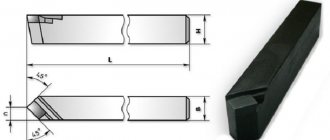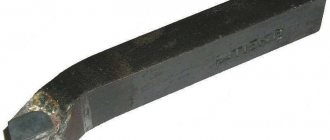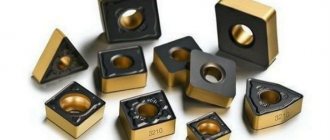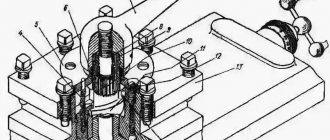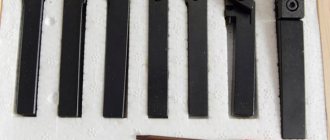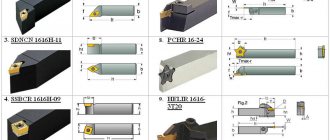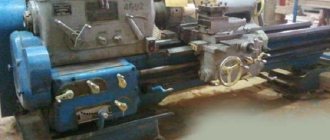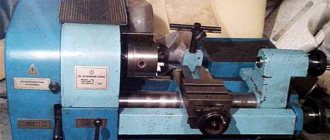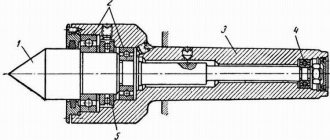Turning cutters through persistent bent - a type of cutting turning tool used for processing cylindrical elements. Suitable for both preliminary and final processing.
They are used in private workshops, in workshops at machine-building plants, etc. Recommended for working with non-rigid objects. Produced in accordance with current GOST 18879-73.
Geometry characteristics
All modifications of turning cutters, persistent bent ones, consist of identical parts. Only the values of some angles change. The main working part is the head on the rod. The rod is attached to the tool holder. The front surface is sharpened at an angle that allows chips to escape.
The main cutting part is the main edge. Formed at the intersection of the main front and back sides. The turning cutter is complemented by an additional cutting edge.
The apex represents the intersection of the main and secondary cutting edges. The model range differs in angles. This is due to the specific purpose and specialization in different types of parts.
A wide range of sizes allows you to choose the best tool for the tasks coming to the workshop. Turning cutters, continuous bent, bent cutters of different sizes can have a rectangular or square cross-section.
Chisels for a wood lathe: types and sizes
Creating wooden cylindrical products is impossible without a hand tool - a chisel for a lathe. It is from under its blade that the unnecessary amount of material is removed and the workpiece acquires an artistic decoration.
Turning chisels can be bought ready-made, but such kits are very expensive, especially high-quality ones. Cutters for wood processing are easy to make yourself, which will be discussed further.
What types of chisels are there?
For professional processing of a wooden workpiece on a lathe, various working tools are required, including a rich set of chisels. Based on their functional role, they can be divided into groups:
- For rough processing. They have 2 cutting edges located at an angle to each other.
- Meisel for finishing. This cutter is a blade with a flat plane and an angular sharpening on the left or right side. The angle of inclination of the cutting part may be different.
- The semicircular reyer chisel is used for working with non-standard products.
- The cut-off cutter is used to remove fragments of wood when forming a pattern.
- A boring tool for wood turning has a shoulder to help remove excess material released during the pointing process.
- Round chisel for processing round products. Its tip can be smooth or jagged.
- Cutting file for processing the end sections of the workpiece.
- The cutter stop is installed on the tool to adjust the turning depth.
Advantages and disadvantages
The advantages of a continuous turning cutter include:
- long service life;
- high resistance to wear of the cutting part;
- processing of complex surfaces;
- high accuracy;
- reduced risk of discarding grinded objects.
For example, high-precision thrust cutters are used on small and stepped elements. The value of the main angle on the working part reaches 90°. Therefore, the level of operating vibration is reduced. There is less chance of accidentally spoiling or damaging the part.
A persistent turning cutter is a working tool designed to perform specific tasks. Manufactured in accordance with the requirements of the standard and correctly used for its intended purpose, it does not have any particular disadvantages. The defect is checked upon purchase.
How to make cutters for a wood lathe with your own hands, their prices
The production of original wooden products on machines requires the availability of a variety of high-quality auxiliary tools. In most cases, wood lathe cutters are used for this. Thanks to them, it is possible to bring the workpiece to the required geometric parameters.
Manufacturers offer all kinds of sets, including products with cutting edges of various configurations. You can also make your own wood cutting tools with your own hands.
Wide selection of shapes and models
When processing wood blanks professionally, it is important to correctly select the appropriate tool for wood turning. A wide selection and large sets with diverse tips will allow you to cover a significant part of the work.
Varieties
Based on functionality, wood chisels are usually divided into the following groups:
- Rough peeling . The tool has a pair of working edges that meet at an acute angle. It is believed that this design is significantly safer than radius analogues.
Raiser for rough roughing
- Finish turning . Similar types of cutters for a wood lathe remove a small layer of chips and are not intended to give the workpiece a shape, but their purpose is to give external smoothness to the outer surface. Metal tips are available with left or right sharpening.
Finishing tool
- wood cutter They are used to work with non-standard surfaces.
Shaped can have almost any configuration
- Cut-off cutter . It is currently relevant for one operation in which it is necessary to separate some part from the workpiece.
Cutting width 10 mm
- Boring . With the help of such products, excess material that appears during the processing process is removed. A special ledge located in the cutting area helps in such an operation.
Boring tool to remove excess wood
- Round wood turning tools They are used for processing radius workpieces. The working part can be either radius or with small technological teeth.
Reyer for turning bowls
- Wood turning at the end is carried out using a conventional cutting file.
- As auxiliary equipment, special stops are used on cutters that limit the depth of cut.
In addition to the standard set, professionals use homemade wood lathe cutters in their work. This approach increases productivity and helps expand the range of finished products.
If you plan to engage in wood processing for a long time, then you cannot do without high-quality tools, which are made from tool-grade steel. It is able to withstand high production intensity, which homemade products are not always capable of.
Homemade wood turning tools
The greatest difficulty in the production of each type of chisel for a lathe is the selection of blanks for the cutting part. In addition to ensuring appropriate hardness, you have to think about the possibility of installing the metal part in the holder. It will allow you to fix the cutter in the desired position for comfortable processing.
Varieties and classification
In accordance with the current interstate standard, continuous turning cutters are produced in 2 types:
- straight lines with an angle of 90° (right and left);
- curved at an angle of 90° (right and left).
Straight through tools grind materials not only on lathes, but also on slotting and planing machines. There are two options:
- Steel made from high-speed steel (GOST 18868-73) - recommended for structures working with heated and non-alloyed parts.
- With a carbide tipped adjacent to a metal frame (GOST 18879-73) - designed for cutting dense metal.
A curved cutter is used as a cutting tool on turning machines. Designed for turning planes of stepped figures, shoulders, and cutting ends. Successfully grinds the outer sides of rotating bodies (cylindrical shafts, conical surfaces, etc.). In this type, two more groups are distinguished depending on the size of the rake angle:
- With an angle of 0° – steel and elements made of viscous materials are processed.
- With an angle of 10° - cast iron products and other fragile substances are processed.
There are finishing and roughing curved turning cutters, persistent ones.
Where to get 3D models of boring tools for SolidWorks
You can, of course, build them from scratch, but there is no point in this when you can simply go to the website and download the model data.
Search on the Sandvik coromant website
To download cutter models, enter the designation of the holders in the search bar at the top of the site, go to the page for this tool and click on the download page.
Download the 3D model of a turning boring cutter A32T-SVUBR 16 for SolidWorks.
Then open this boring cutter in SolidWorks.
Cutter A32T-SVUBR 16 in SolidWorks
After which we do the same for the A25T-SDUCR 11 and open it in SolidWorks.
Cutter A25T-SDUCR 11 in SolidWorks
A25T-SDUCR 11 boring tool will be used as roughing tool and A32T-SVUBR 16 will be used as finishing tool. This can be seen further in the turning animation.
Selection criteria
When choosing a turning thrust cutter for a lathe, you should pay attention to economic and practical circumstances. Regardless of the price range, you need to choose a tool that is suitable for the task ahead. The parameters must match exactly. Should be considered:
- angular geometry;
- cutter shape;
- the material from which the cutting part is made;
- size.
For long-term work, experienced craftsmen advise purchasing a persistent turning cutter made of hard alloy. When the temperature begins to rise, high-speed steel will begin to lose its qualities. This can cause a breakdown at the wrong time, and will definitely cause rapid wear and tear.
Curved models have proven themselves in practice to be more practical and versatile. When getting acquainted with the assortment, you should pay special attention to them. Straight turning cutters, persistent ones, perform a simpler set of operations. The dimensions of the tool must correspond to the dimensions of the future workpiece.
Types of groove cutters
Turning tools for forming grooves include cutters for internal and external machining. Both the first and second can be made entirely of carbide materials or have a replaceable cutting part. Carbide cutters are a fairly expensive tool, so their use must be economically feasible. When performing external work, products with replaceable inserts are usually used; using carbide groove cutters in such cases does not make sense.
The situation is completely different with the processing of internal grooves. Here it is necessary to take into account the diameter of the hole into which the cutter is to be inserted, as well as the rigidity of the tool. The requirements for a cutter to have a minimum size of its holder and sufficient rigidity to perform metal processing are met only by carbide groove tools.
Naturally, when the processing conditions and geometric parameters of the workpiece allow it, it is more advisable to use an inexpensive tool with replaceable inserts to form external and internal grooves.
GOST 18879-73 (download)
What are the operating modes?
There are two main cutting modes in which a persistent cutter is used. This is roughing and finishing. The first is done with movements in the direction along and across. Most of the metal is removed. During the process, the persistent turning cutter experiences the heaviest loads.
Next, the master begins to perform one of the finishing options. The object is given the required shape and exact dimensions. The tool moves slowly and carefully. At minimum speed, fractions of a millimeter are removed.
Accurate sharpening allows you to obtain the correct parts. It is recommended to have in stock several different versions of a continuous turning cutter, taking them out to perform certain tasks.
Universal boring turning tools
Boring turning tools are used for machining holes and internal surfaces. These cutters are divided into two types:
1. For processing blind holes , the cutting plate of such cutters has a triangular shape, and the working part is made with a bend.
Universal turning boring tool for blind holes.
2. For processing through holes , the working part of these cutters also has a bend, and this cutter is used for boring pre-drilled holes or for boring holes in pipes.
Universal turning boring tool for through holes.
The maximum machining depth of the holes of these cutters depends on the size of the holder.
